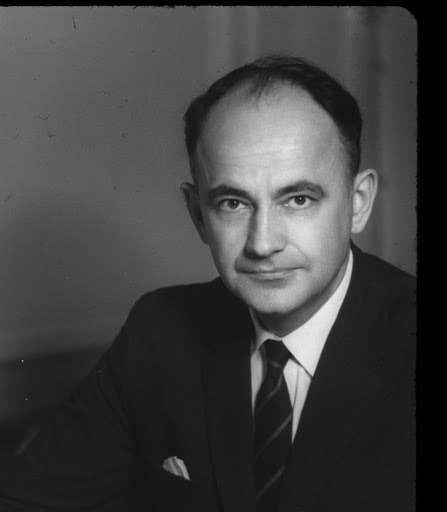Joseph Vincent Charyk (September 9, 1920 – September 28, 2016) was widely credited as the founder of the geosynchronous communications satellite industry. He was born in Canmore, Alberta in a Ukrainian family. Early in his career, Charyk consolidated the Central Intelligence Agency, United States Air Force, and United States Navy space programs into the National Reconnaissance Office (NRO). He brought the first United States imagery satellite, CORONA, into operation and demonstrated signals intelligence technology from space. During his tenure, the NRO operated the U-2 reconnaissance aircraft and managed development of the A-12. – Wikipedia. His career path was as follows:
After graduating from the University of Alberta, he came to the United States, earning a Ph.D in Aeronautics, magna cum laude (top excellence), from California Institute of Technology, where he was mentored by the renowned aerodynamic theoretician Theodore von Kármán. It was at the Jet Propulsion Laboratory at Caltech where he met his lifelong love, Edwina Rhodes, whom he would marry on August 18, 1945. Joe and Edwina moved to Princeton in 1946. Charyk was a Professor of Aeronautics at Princeton University from 1946 to 1955, where he helped to establish the Guggenheim Jet Propulsion Center. It was during his years at Princeton that Charyk accompanied his mentor Professor von Kármán on visits to the home of Albert Einstein…
Opportunities at Lockheed Aircraft Corporation, and the aeronautics division of Ford Motor Company brought the Charyks to California in 1957. Two years later, the Charyk family was on the move again, this time to Washington, DC, where Charyk served as Assistant Secretary-Chief Scientist of the United States Air Force from 1959 until he was appointed Undersecretary of the Air Force. Details of the appointement were dramatic:
On May 1, 1960 the Soviet Union shot down an American U-2 aircraft piloted by Francis Gary Powers, forcing President Dwight Eisenhower to halt aerial overflights over the Soviet Union. At the time, the United States had two ongoing programs to develop satellite reconnaissance systems: the SAMOS program run by the Air Force and the CORONA program run by the CIA. However, both of these programs were experiencing difficulties at the time of the U-2 shoot down: all eleven of the CORONA launches to date had resulted in failure.
A joint report submitted to President Eisenhower on August 25, 1960 on the technical aspects of the SAMOS program and plans on how to employ the resulting system led to a reorganization of the Air Force satellite program. As a result, the manager of the program began reporting directly to the Undersecretary of the Air Force, Joseph V. Charyk, who reported directly to the Secretary of Defense…
In 1961, Dr. Charyk was appointed by President John F. Kennedy to concurrently serve as the first Director of the National Reconnaissance Office, a consolidation of the Central Intelligence Agency, United States Air Force, and United States Navy space programs. He brought the first United States imagery satellite, CORONA, into operation and demonstrated signals intelligence technology from space. During Charyk’s tenure, the NRO operated the U-2 reconnaissance aircraft and managed development of the A-12. In September 1962, as NRO Director, Charyk played a central role in providing critical intelligence to President Kennedy and his top advisors throughout the Cuban Missile Crisis.
Dr. Charyk became President and a director of the Communications Satellite Corporation (COMSAT), shortly after the organization’s inception in 1963. His efforts launched a global system that would eventually seem commonplace to billions of people around the world. While at Comsat, Charyk served as President, CEO, and Chairman from 1963 to 1985.
In 1974, he received the International Emmy Directorate Award for his work with Comsat. In 1987, President Ronald Reagan awarded Charyk the National Medal of Technology and Innovation “for employment of the concept of the geosynchronous communications satellite systems as the basis for a global telecommunications system, established by international agreement, and for his guidance in the development and growth of the Intelsat system, which today services over 150 nations and territories.”
